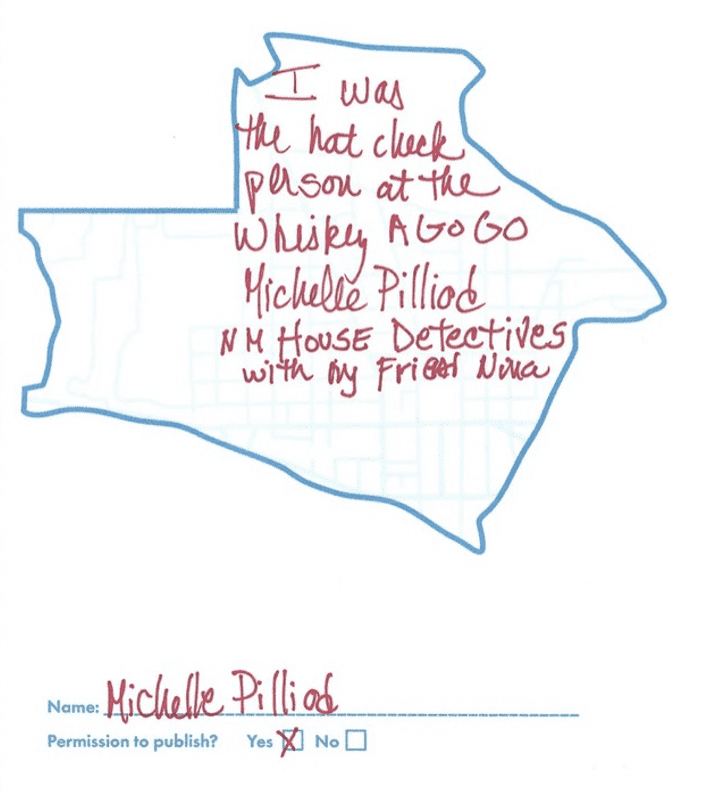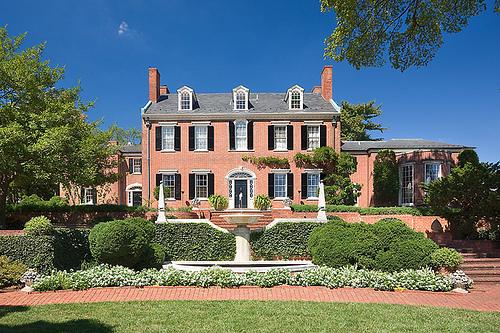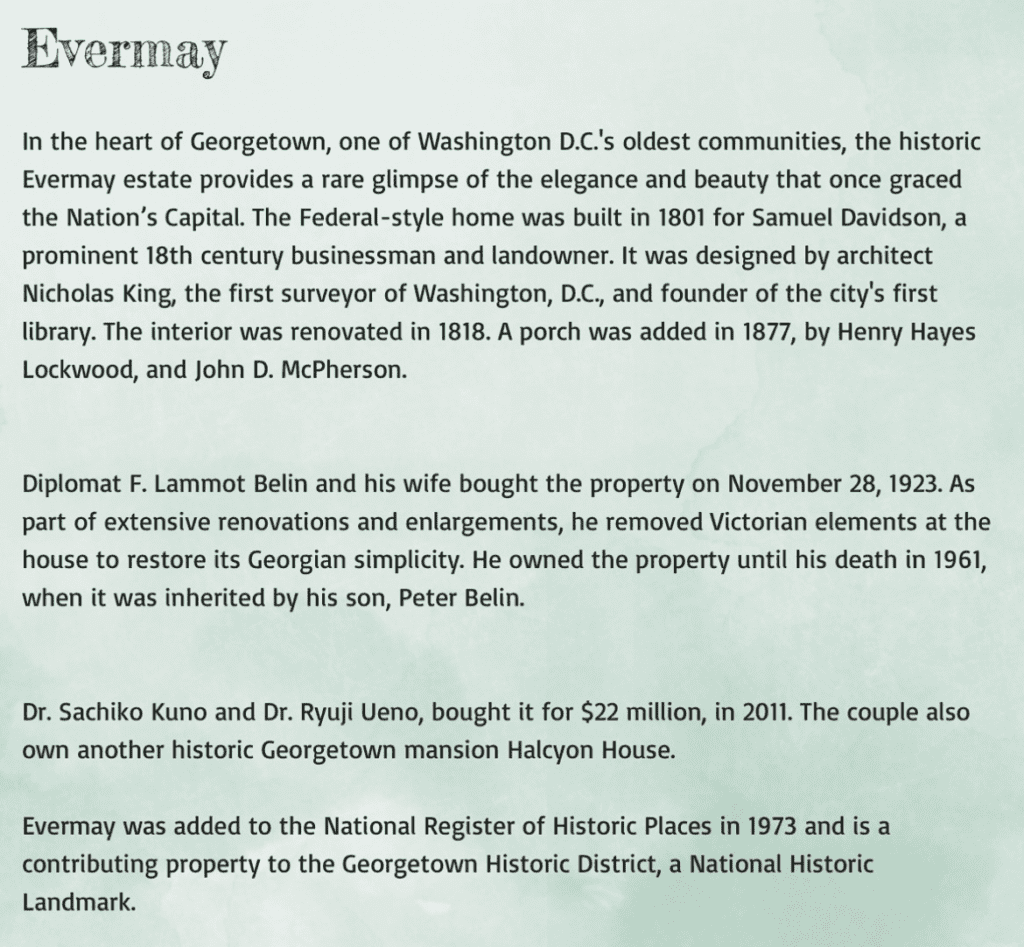Mapping Georgetown: From Hat-Checking to House Detectives
By • March 31, 2022 0 1842

Here at the Mapping Georgetown project, we collect stories. And this one from Michelle Pilliod caught our eye!
“I was a hat check person at Whisky A-Go-Go,” Pilliod began… Then Pilliod became a “house detective” with her friend Nina Tristani and the rest is, literally, history….
Michelle Pilliod’s Mapping Georgetown Story

Michelle Pilliod’s Story-Map. Courtesy Mapping Georgetown.
Michelle Pilliod and Nina Tristani, we are the House Detectives. After retiring from my meeting planning business, my friend Nina and I researched the history of our Capitol Hill houses. We enjoyed it so much that we started N&M House Detectives. We now have over 70 books completed. Our friend Mike Walsh, retired Park Service, helps with research. You can find us at nmhousedetectives.com.
The Washington Post’s Take on N&M House Detectives
The burgeoning “house detective” business in Washington, D.C. caught the eye of The Washington Post in 2019. N&M House Detectives were featured as follows:
Michelle Carroll [Pilliod] and Nina Tristani started N&M House Detectives in Washington about five years ago after researching the history of their own homes. They have uncovered the histories of about 30 houses and recently branched out to businesses.
“We get very wrapped up in these houses,” Carroll [Pilliod] said. “Sometimes we get more excited than the homeowners.”
They discovered that an owner of a house was the doorman at Ford’s Theatre the night President Lincoln was shot. Another house they researched was listed in the Green Book, a book used by African Americans when traveling in the Jim Crow South.
Carroll [Pilliod] and Tristani, who spend about six weeks on each house, have uncovered the histories of more recent houses as well.
“Even if the house was built in the 1980s it still has a history to it, a history to the land,” Tristani said.
Copies of whatever documents they find related to a house are given to the homeowner. Some of those documents — such as the original deed — and photos are included in the hardback, glossy-page coffee table book they present to their clients…
N&M House Detectives Explore the Evermay estate of Georgetown:
In Georgetown, the N&M House Detectives explored the history of the lush Evermay Estate.
https://www.nmhousedetectives.com/single-post/2020/01/26/evermay

Evermay Estate of Georgetown. Georgetowner photo.

Text from N&M Detective’s research on the Evermay Estate of Georgetown. Photo courtesy N&M Detectives.
The sale of the Evermay Estate in 2011 was described in The Georgetowner this way:
Georgetown’s historic Evermay Estate, which was listed by Jeanne Livingston of Long and Foster, was sold this week with a final listing price of $25.9 million, making it the most expensive home sale in the D.C. area since 2007. Mark McFadden of Washington Fine Properties represented the buyers in this historic sell.
On July 8, the property held a very successful estate sale, auctioning off items such as linens, glasses and books.
Evermay has been on the market since 2008, when it was originally listed for $49 million, according to Washingtonian. Although the final listing price was $25.9 million, D.C. Urban Turf reports that its final sales price was $22 million. Washington Fine Properties cannot yet say who is the buyer of the Evermay Estate.
This will mark the first time the property is owned by a new family since 1923 when Evermay was sold to F. Lammot Belin, the heir of DuPont Chemical, who passed the estate down through three generations.
The home, which is included in the National Register of Historic Places, is 12,000 square feet sitting on 3.5 acres, and contains a ballroom, gardens, tennis court, gate house, parking for 100 cars and enough dining space for 40 dinner guests.
N&M Detectives Also Researched Georgetown and D.C. Public Markets:
In the mid-eighteenth century, public markets in Piscataway, Bladensburg, and Georgetown, in Maryland, and in Alexandria, Virginia served both shoppers and vendors in the area which was soon to become the District of Columbia. No markets were planned for inside the limits of the Federal City when it was laid out in 1790. However, markets were such an essential piece of urban life that Thomas Jefferson included public markets in his list of necessities to be incorporated into the making of the new Capital City. Pierre L’Enfant, in his June 22, 1791, report to George Washington, proposed an arrangement of waterways which would allow foodstuffs to be supplied by boat to the city’s markets.
After six years, in 1797, the President himself assigned parcels of land to be put aside for three open markets: Center Market, Western Market, and Eastern Branch Market. (Public Markets were located in permanent structures and open year-round as opposed to Farmers’ Markets that could be seasonal and located outside.)
These market destinations were population-specific; that is, the markets’ locations reflected the early patterns in the city’s population density. The city of Washington did not have a real farmers market until the Center Market was built in 1801…
https://www.nmhousedetectives.com/single-post/2017/08/29/original-dc-public-markets
—
Thank you, Michelle and Nina, for the time and effort that you put into sharing your story with our Georgetown community project! Your story is both a fun and educational read and your passion, an inspiration!
—
To learn more about the Mapping Georgetown project see https://georgetowner.com/articles/2021/07/19/marilyn-butlers-vision-for-mapping-georgetown/.
To submit your Georgetown recollections to Mapping Georgetown go to www.mappinggeorgetown.com or visit the Georgetown Public Library to pick up a physical map-story form to fill out.
Marilyn Butler can be reached at: marilyn.butler@gmail.com.

